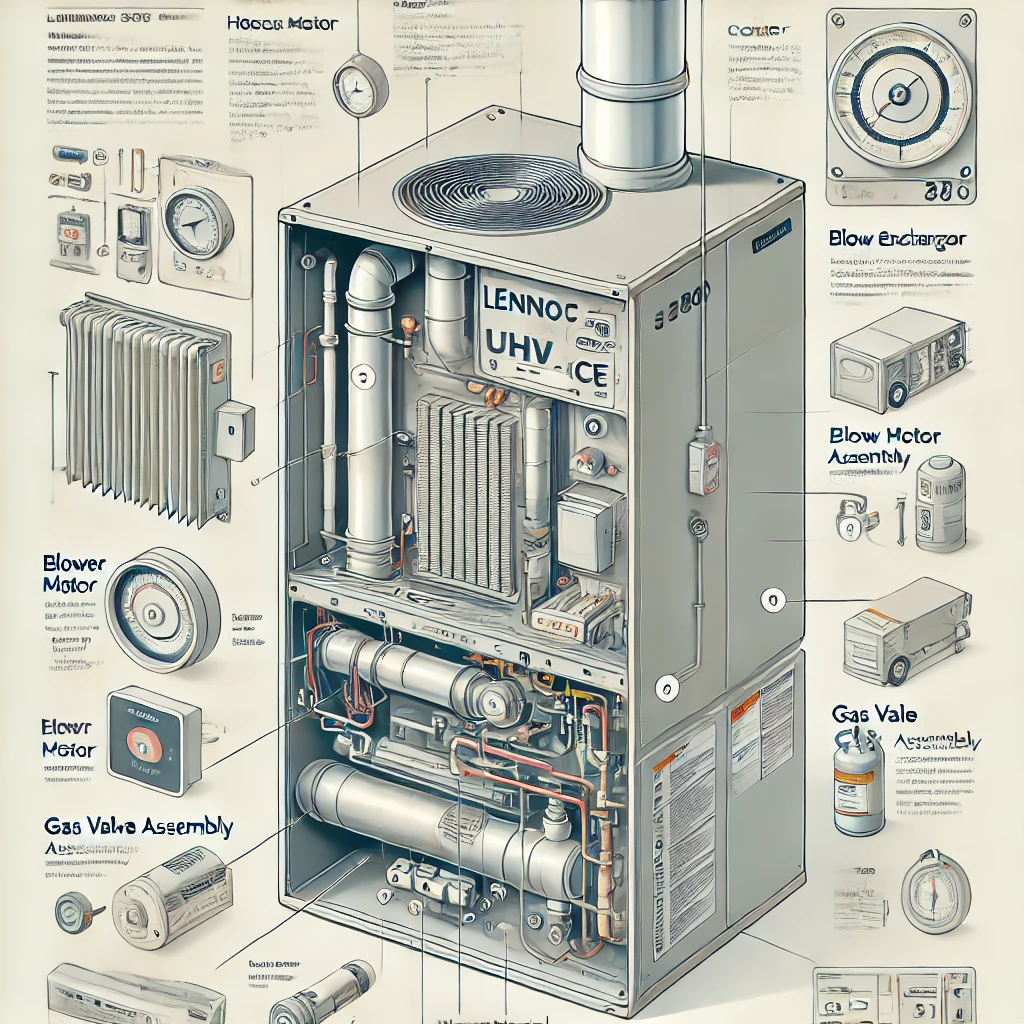Are you seeking a clear guide to your Lennox SL 280 UHV exploded view diagram? Let me explain it to you!
The Basics You Need to Know
Right off the bat:
- The SL 280 UHV is a two-stage furnace
- It runs at 80% efficiency
- The parts diagram shows every piece
- Each component has a unique number
- The system uses variable-speed tech
- Built for long-term reliability
- Works with dual fuel setups
- Features low noise design
Finding Your Way Around the Diagram
The diagram splits into these main sections:
- Front panel assembly
- Heating components
- Blower section
- Control area
- Gas valve assembly
- Venting system
- Electrical connections
- Safety components
Essential Parts You’ll See
Main stuff that matters:
1. Heat Exchanger
- Made of aluminized steel
- Handles the actual heating
- Contains burner assembly
- Shows all connection points
- Features backup systems
- Lists safety controls
- Shows heat flow paths
- Maps sensor spots
2. Blower Motor
- Variable speed design
- Moves air through the system
- Shows mounting brackets
- Lists all fasteners needed
- Details wiring paths
- Notes speed settings
- Maps airflow patterns
- Shows service points
3. Control Panel
- The brain of the system
- Shows wire connections
- Labels safety switches
- Maps sensor locations
- Lists test points
- Shows LED indicators
- Notes jumper settings
- Details troubleshooting lights
Reading Part Numbers
Here’s the simple way:
- First 3 digits = part type
- Middle section = model series
- Last bits = version number
- Letter codes = special features
- Color codes = wire types
- Size marks = fitting sizes
- Batch numbers = production date
Common Fix-It Spots
These parts need the most attention:
- Flame sensor (yearly cleaning)
- Pressure switch (check springs)
- Draft motor (bearing wear)
- Ignitor (replacement part)
- Control board (power issues)
- Gas valve (regulation checks)
- Limit switches (safety tests)
- Thermostat (signal checks)
Making Sense of Assembly Lines
The arrows tell you:
- Which way do parts fit
- How things come apart
- What connects where
- Assembly order
- Wiring routes
- Gas line paths
- Airflow direction
- Safety component placement
Real-Life Example
Last week, I helped my mate fix his unit:
- Used diagram to find parts
- I spotted the lousy sensor
- Matched the numbers
- Fixed it in 30 minutes
- Saved him loads of cash
- Taught him basic maintenance
- Set up regular checks
- Made a spare parts list
Tips From the Field
Stuff I’ve learned:
- Take pictures before taking them apart
- Keep screws sorted by section
- Mark wires before disconnecting
- Double-check part numbers
- Label all connections
- Document changes made
- Keep notes on repairs
- Track maintenance dates
Safety Bits You Can’t Skip
Before you start:
- Kill the power
- Turn off gas
- Let it cool down
- Get proper tools ready
- Check carbon monoxide detector
- Clear work area
- Have first-aid kit
- Keep a fire extinguisher handy
Finding Replacement Parts
Simple steps:
- Get the part number
- Check local suppliers
- Compare prices
- Verify compatibility
- Check warranty coverage
- Order spares if needed
- Keep receipts
- Document installations
Maintenance Made Easy
Monthly checks:
- Filter condition
- Weird noises
- Even heating
- Clean sensors
- Check temperatures
- Listen for changes
- Watch flame color
- Note run times
Yearly must-dos:
- Full inspection
- Deep cleaning
- Part updates
- Performance test
- Efficiency check
- Safety system test
- Vent inspection
- Bearing lubrication
Quick FAQs about Lennox SL 280 UHV Exploded View Diagram
Q: Where’s my model number?
A: Check inside front panel, top corner
Q: Can I fix it myself?
A: Simple stuff, yes; complex, no
Q: How often should I check?
A: Monthly basics, yearly deep check
Q: What tools do I need?
A: The essential toolkit covers most jobs
Q: When should I replace parts?
A: At first signs of wear or failure
Q: How long do parts last?
A: Varies by use, usually 5-15 years
Q: What voids warranty?
A: DIY complex repairs, wrong parts
Q: Need special training?
A: For complex stuff, yes
Pro Tips Worth Gold
Smart moves I’ve learned:
- Keep diagram copy handy
- Store spare parts
- Write down repairs
- Track maintenance dates
- Photo document changes
- Record error codes
- Note unusual sounds
- Keep service records
Common Mistakes to Skip
Don’t do these:
- Skip steps in order
- Guess at part numbers
- Force tight fits
- Mix up similar parts
- Ignore small noises
- Skip regular checks
- Use wrong tools
- Rush repairs
When to Call Help
Get a pro when:
- Electrical issues show up
- Gas problems appear
- Major parts fail
- Safety concerns pop up
- Strange smells occur
- Unusual noises start
- Performance drops
- Energy bills spike
Parts Worth Keeping
Stock these spares:
- Ignitor
- Flame sensor
- Basic filters
- Common fuses
- Thermostat batteries
- Door switches
- Basic fasteners
- Wire connectors
Making It Last
Smart habits:
- Regular checks
- Clean components
- Watch for wear
- Keep records
- Follow schedule
- Replace filters
- Check connections
- Listen carefully
Understanding Error Codes
Basic codes mean:
- 3 flashes = pressure switch
- 4 flashes = high limit
- 5 flashes = flame issues
- 6 flashes = pressure
- 7 flashes = rollout
- 8 flashes = ignition
- 9 flashes = low voltage
- 10 flashes = internal error
Seasonal Checks
Before winter:
- Test all systems
- Clean thoroughly
- Check connections
- Update parts needed
- Check heat output
- Test safety systems
- Clean burners
- Verify pressures
Tools You’ll Want
Basic kit needs:
- Socket set
- Wire strippers
- Multimeter
- Screwdrivers
- Pressure gauge
- Temperature probe
- Safety glasses
- Work gloves
Final Thoughts – Lennox SL 280 UHV Exploded View Diagram
Knowing your Lennox SL 280 UHV exploded view diagram saves time and money. It’s your map to keeping your system running right.
Keep this guide handy—you’ll need it the next time you work with that Lennox SL 280 UHV exploded view diagram.

![Amazon Customer Relationship Management byHyperzon: Ultimate Guide [2024]](https://newzire.com/wp-content/uploads/2024/10/DALL·E-2024-10-26-21.28.10-A-simple-clean-picture-of-an-Amazon-CRM-dashboard-by-Hyperzon-focusing-on-key-metrics-like-customer-retention-rate-repeat-purchase-rate-and-averag.webp)
